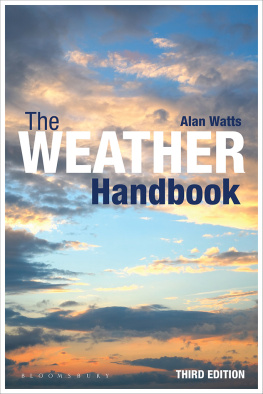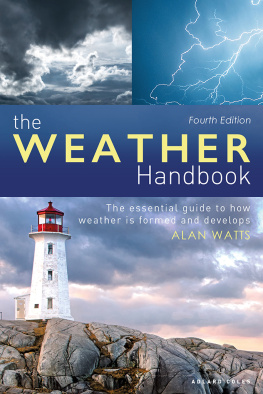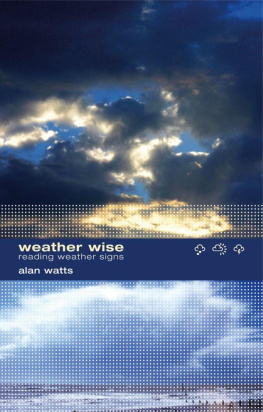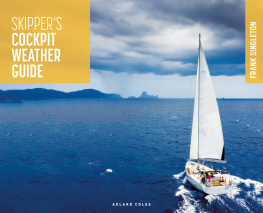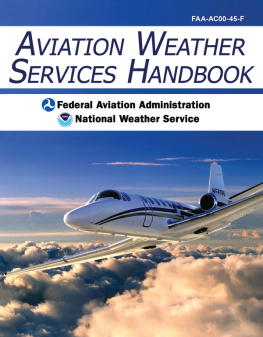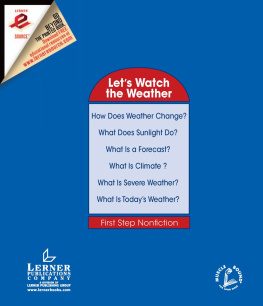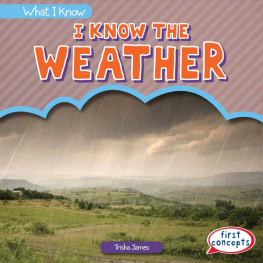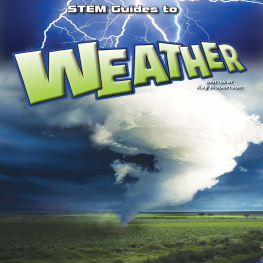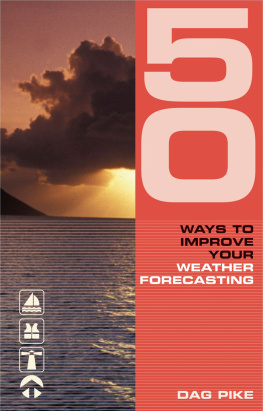
Contents

About this book
Back in the summer of 1967 I had an idea for a book on the weather: 24 full-page colour photographs of cloud formations and, on the facing page, notes on what the clouds meant. We called it Instant Weather Forecasting. It is still in print in approaching a dozen languages, the most recent being Russian. This success over such a long time shows how much people want to try forecasting the weather themselves. They may not be as successful as the present-day meteorologists but the desire is there. In any case, because weather is so variable from one place to another, the observer on the spot can do something that the professionals cannot hope to emulate see the state of the right-now weather as it affects them.
What the professional met-men do these days is, to me (who used to be one of them), quite magical. They have programmed and refined powerful computers that, usually quite accurately, foretell the shape of the isobars and the positions of the lows and highs and fronts for ten or more days ahead, plus many other things. They can tell you how the 6-mile high upper winds that control much of the surface weather will be blowing a fortnight from now and get it pretty accurate. But there are still important things they cannot yet do (and probably never will be able to), for example: predict on a showery day when and where you will be hit by a shower. Only you, looking at your sky, can see the shower clouds coming and only you will know when the rain leaves off.
Instant Weather Forecasting tried to help with things like that. However, there are many people who would like to know more about the processes of weather, to integrate this knowledge with the forecasts. They may well be put off by the complexity of all things meteorological, but no one can run before they can walk and if you have a desire to run this book may help to set you on your feet.
We start with sky watching. You cannot become a local weather forecaster unless you train yourself to watch the sky. Then you have to dissect what you see: separate the cloud-decks and see what they may mean.
One major thing that the computer revolution has spawned is a realisation that the worlds weather is an entity. Your weather is the end result of things that have happened in the atmosphere over vast distances and through great depths. You get a new perspective when you see the clouds from space (and realise how beautiful they are).
Different weather patterns are governed by areas of high and low pressure and we can set ourselves in the local pressure-pattern from a glance at the TV weather presentations and, on a smaller scale, the local cloud-scape and the wind direction.
Diff erent weather comes from enormous blocks of air called airmasses, and recognising what kind of airmass you have helps greatly to put you in the weather picture. When airmasses clash fronts form and you need to know what weather usually goes with warm fronts, cold fronts and occluded fronts, because it is from these that most of what we call weather stems. This book goes into a lot of detail about these.
When the weather is good then the sunshine has a significant bearing on how the day will pan out. These daily (diurnal) changes follow the sun but also depend on whether youre on land or near the coast. Knowledge of these normal diurnal changes will help explain many things that happen during the day.
We explain about local winds, like sea-breezes, that often govern the way the summer days develop, and also what happens when the sun goes down. You need particular information about the sudden changes in the weather when you go into the hills and the mountains.
My book Instant Storm Forecasting explains hurricanes and tornadoes, but as they are not often experienced in the temperate regions at which this book is aimed, they are ignored here. However, one bad-weather entity we all experience is the thunderstorm. A chapter is devoted to that in this book.
Finally, the atmosphere is a heat engine and obeys certain fundamental laws you dont have to read this chapter () unless you want to, but let me say that the more you understand about the weather the more interesting it becomes.


I live in a meteorological no-mans-land called north-east Essex. We lie under that fuzzy line of division between the forecast areas of East Anglia, which is further north, and south-east England which is further south and really the other side of the Thames Estuary. When we get the forecast for East Anglia we always have to ask Do they mean us or should we be under the south-east England bit?
There are thousands of people like us all over the world, who for one reason or another often do not think that the forecast applies to them. Sometimes this is because of the peculiar pattern of hills and valleys, rivers and coastlines that lie upwind of them. Sometimes it is because of the impossibility of being able to give sufficiently detailed descriptions of the weather in the very limited time that the media allow for each forecast slot. When you sum up the total time devoted to forecasts by all the radio and TV stations of your area it amounts to a sizeable period but as they are all saying the same thing in slightly different ways it just means that a fuzzy view of the weather gets reiterated time after time.
This state of affairs stems from the remarkable revolution that has occurred in the business of forecasting by computer. There is no doubt about it and you can accept it from me, an ex met man the forecasts that come from a happy marriage of human forecaster and machine are much more accurate and detailed than they were in the old days when we had to do it by hand. Now the most massive computers in the world crunch immense sets of numbers and regurgitate reams of charts of what the isobars and upper-air contours are going to look like tomorrow, the next day and maybe six days or more ahead. Together with satellite cloud pictures taken both in visible light and in infra-red, radar plots of where the rain is falling and an onward-going better appreciation of the processes of weather, the computer/human method of forecasting is a great success.
I was a forecaster back in the fifties but I have tried not to lose contact with the amazing growth of the forecasting game since then. However that does not often stop me being amazed when they get the general weather right for, say, Friday, when it is as yet only Monday. We could never have done that in our day except in exceptional circumstances. Today it is done every day, day-in and day-out on 365 days a year with an extra day when its a leap year.
In my day, not long after the Second World War, there were many more airfields etc sending in observations than there are today. Weather forecasting starts with observations. If it were not for the unsung heroes whose job it is to observe the weather across the entire world, and sometimes in the most remote and inhospitable places, there would be no forecasts. Computers are wonderful but they need input.
So how have the meteorological powers-that-be bridged the immense gaps that have appeared in the observing network? The answer is, with the computer which works with the so-called equations of motion of the atmosphere and can fill in the spaces. It could be more accurate if there were more observing stations but there arent and the number could get fewer.
Next page
